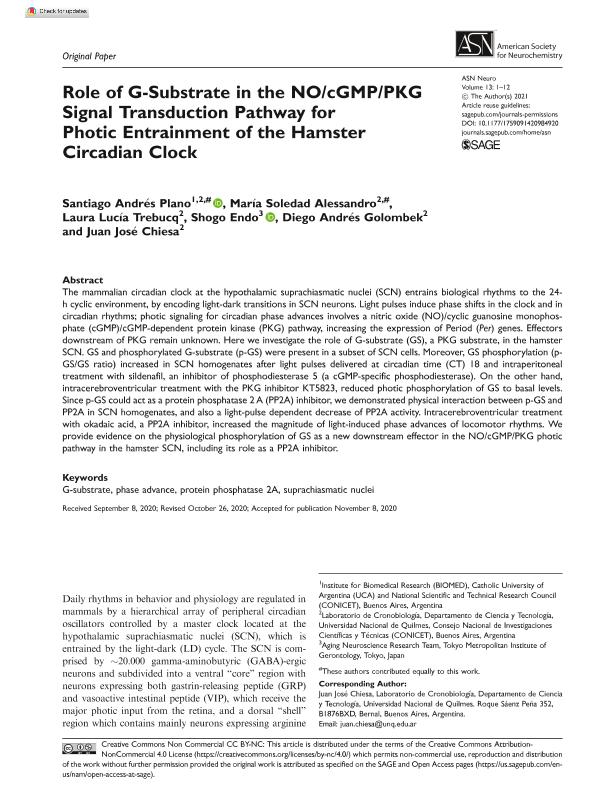Artículo
Role of G-Substrate in the NO/cGMP/PKG Signal Transduction Pathway for Photic Entrainment of the Hamster Circadian Clock
Plano, Santiago Andrés ; Alessandro, Maria Soledad
; Alessandro, Maria Soledad ; Trebucq, Laura Lucia
; Trebucq, Laura Lucia ; Endo, Shogo; Golombek, Diego Andrés
; Endo, Shogo; Golombek, Diego Andrés ; Chiesa, Juan José
; Chiesa, Juan José
 ; Alessandro, Maria Soledad
; Alessandro, Maria Soledad ; Trebucq, Laura Lucia
; Trebucq, Laura Lucia ; Endo, Shogo; Golombek, Diego Andrés
; Endo, Shogo; Golombek, Diego Andrés ; Chiesa, Juan José
; Chiesa, Juan José
Fecha de publicación:
01/2021
Editorial:
SAGE Publications
Revista:
ASN Neuro
ISSN:
1759-0914
Idioma:
Inglés
Tipo de recurso:
Artículo publicado
Clasificación temática:
Resumen
The mammalian circadian clock at the hypothalamic suprachiasmatic nuclei (SCN) entrains biological rhythms to the 24- h cyclic environment, by encoding light-dark transitions in SCN neurons. Light pulses induce phase shifts in the clock and in circadian rhythms; photic signaling for circadian phase advances involves a nitric oxide (NO)/cyclic guanosine monophos- phate (cGMP)/cGMP-dependent protein kinase (PKG) pathway, increasing the expression of Period (Per) genes. Effectors downstream of PKG remain unknown. Here we investigate the role of G-substrate (GS), a PKG substrate, in the hamster SCN. GS and phosphorylated G-substrate (p-GS) were present in a subset of SCN cells. Moreover, GS phosphorylation (p- GS/GS ratio) increased in SCN homogenates after light pulses delivered at circadian time (CT) 18 and intraperitoneal treatment with sildenafil, an inhibitor of phosphodiesterase 5 (a cGMP-specific phosphodiesterase). On the other hand, intracerebroventricular treatment with the PKG inhibitor KT5823, reduced photic phosphorylation of GS to basal levels. Since p-GS could act as a protein phosphatase 2 A (PP2A) inhibitor, we demonstrated physical interaction between p-GS and PP2A in SCN homogenates, and also a light-pulse dependent decrease of PP2A activity. Intracerebroventricular treatment with okadaic acid, a PP2A inhibitor, increased the magnitude of light-induced phase advances of locomotor rhythms. We provide evidence on the physiological phosphorylation of GS as a new downstream effector in the NO/cGMP/PKG photic pathway in the hamster SCN, including its role as a PP2A inhibitor.
Palabras clave:
Substrate G
,
PKG
,
Suprachiasmatic
,
Circadian
Archivos asociados
Licencia
Identificadores
Colecciones
Articulos(BIOMED)
Articulos de INSTITUTO DE INVESTIGACIONES BIOMEDICAS
Articulos de INSTITUTO DE INVESTIGACIONES BIOMEDICAS
Articulos(SEDE CENTRAL)
Articulos de SEDE CENTRAL
Articulos de SEDE CENTRAL
Citación
Plano, Santiago Andrés; Alessandro, Maria Soledad; Trebucq, Laura Lucia; Endo, Shogo; Golombek, Diego Andrés; et al.; Role of G-Substrate in the NO/cGMP/PKG Signal Transduction Pathway for Photic Entrainment of the Hamster Circadian Clock; SAGE Publications; ASN Neuro; 13; 1-2021; 1-12
Compartir
Altmétricas



